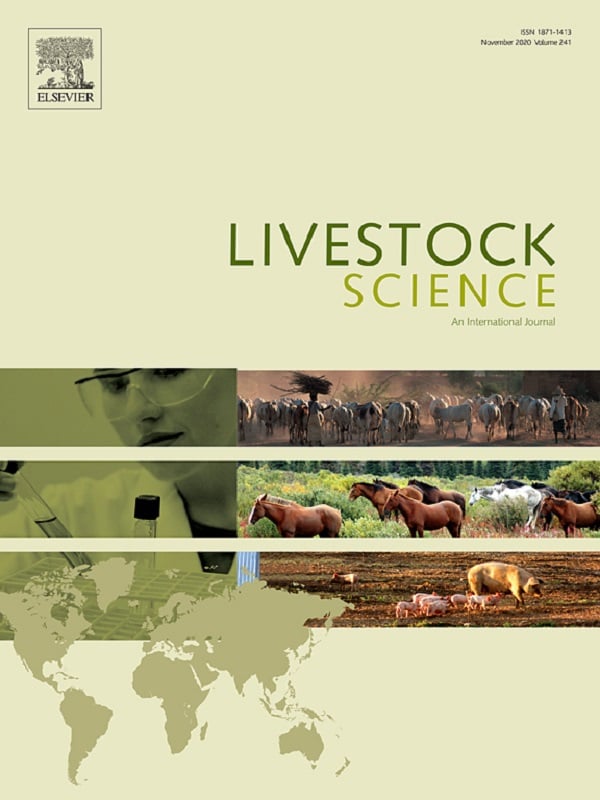Performance and greenhouse gas emission of Nellore and F1 Angus × Nellore yearling bulls in tropical production systems during backgrounding and finishing
Erick Escobar Dallantonia, Marcia Helena Machado da Rocha Fernandes, Abmael da Silva Cardoso, Rhaony Gonçalves Leite, Adriana Ferrari, Fernando Ongaratto, Josiane Fonseca Lage, Marco Antonio Alvares Balsalobre, Ricardo Andrade Reis,
Performance and greenhouse gas emission of Nellore and F1 Angus × Nellore yearling bulls in tropical production systems during backgrounding and finishing, Livestock Science, Volume 251, 2021, 104646, ISSN 1871-1413,
https://doi.org/10.1016/j.livsci.2021.104646
(https://www.sciencedirect.com/science/article/pii/S1871141321002547)
- Ruminants
- Sustainability
- Beef
- 2021
Josiane Fonseca Lage

Highlights
- We evaluated GHG emission of Nellore and F1 Angus x Nellore yearling bulls.
- They were raised under two beef production systems (lenient and intensified) in tropical pasture.
- F1Angus grew faster and are heavier than Nellore bulls.
- Carbon footprint of F1Angus in intensified production system were the lowest.
- Improvement of genetic merit and pasture management decreases environmental impact.
Abstract
This study investigated the performance, carcass traits, and greenhouse gas emission of Nellore and F1 Angus × Nellore yearling bulls raised under two [lenient (S1) and intensified (S2)] production systems during the backgrounding and finishing phases. S1 was practiced on a 18.6 ha palisade grass pasture, divided into eight paddocks, which was not fertilized and managed using continuous stocking at a constant rate of two animals per hectare during backgrounding. Then, 20 Nellore [initial body weight (BWi), 277±13 kg; initial age, 15.2±1.1 months] and 20 F1 Angus × Nellore (BWi, 304±21 kg; initial age, 15.8±0.44 months) yearling bulls were randomly allocated to four paddocks for each breed. During finishing, animals remained on the pasture and received high supplementation (at rate of 2.0 kg•100 kg−1 BW). S2 was practiced on a 11.4 ha palisade grass pasture, divided into six paddocks, which was fertilized (150 kg N•ha−1•year−1) and managed using continuous stocking at variables rates during backgrounding. Then, 24 Nellore (BWi, 288±16 kg; initial age, 15.6±0.65 months) and 24 F1 Angus × Nellore (BWi, 325±18 kg; initial age, 15.8±0.42 months) yearling bulls were randomly allocated to three paddocks for each breed. During finishing, the bulls were moved to feedlots. During backgrounding, F1 Angus × Nellore bulls in S2 achieved the highest average daily gain (ADG) and final shrunk body weight (SBWf), whereas Nellore bulls in S1 achieved the lowest ADG and SBWf. During finishing, ADG and SBWf were greater in S2 than in S1 as well as for F1 Angus × Nellore bulls than for Nellore bulls. From the beginning of backgrounding until the end of finishing, the ribeye area of F1 Angus × Nellore bulls in S2 was larger than that of other bulls. The greatest backfat deposition occurred during finishing, resulting in greater backfat thickness of bulls in S2 than that of bulls in S1. The carbon footprint of F1 Angus × Nellore bulls in S2 (10.8 kg•CO2e•kg−1 carcass) was similar to that of Nellore bulls in S1, but it was approximately 13% and 11.5% lower than that of Nellore bulls in S2 and F1 Angus × Nellore bulls in S1, respectively. This study demonstrated that the enhancement of productivity through improving genetic merit and pasture management is a suitable strategy to reduce environmental impact and achieve environmental sustainability.